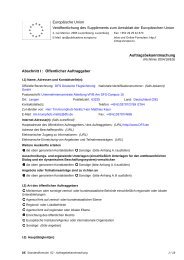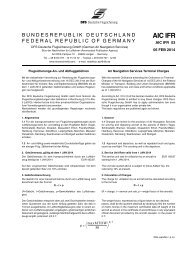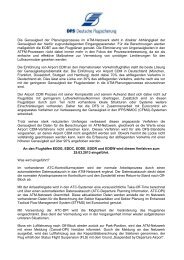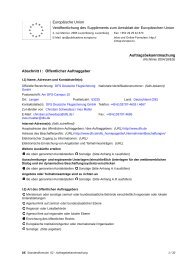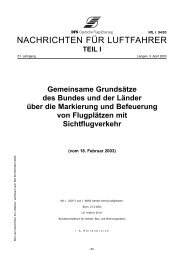TE im Fokus 02/2013 - DFS Deutsche Flugsicherung GmbH
TE im Fokus 02/2013 - DFS Deutsche Flugsicherung GmbH
TE im Fokus 02/2013 - DFS Deutsche Flugsicherung GmbH
Erfolgreiche ePaper selbst erstellen
Machen Sie aus Ihren PDF Publikationen ein blätterbares Flipbook mit unserer einzigartigen Google optimierten e-Paper Software.
Informationen aus dem Bereich Forschung und Entwicklung<br />
der <strong>DFS</strong> <strong>Deutsche</strong> <strong>Flugsicherung</strong> <strong>GmbH</strong><br />
Fig. 8: HPA analysis using SASS-C V6.7<br />
The results with the DAWC Tool showed significant<br />
better results due to very high calculation<br />
resolution and an opt<strong>im</strong>ized association algorithm<br />
taking into account the specific t<strong>im</strong>ing characteristics<br />
of ADS-B and WAM data. SASS-C V6 had<br />
an internal calculation resolution of 30m, which is<br />
in the order of the expected ADS-B/WAM positional<br />
errors. This led to the conclusion that the<br />
tool itself affects the validity of the HPA results.<br />
Fig. 9: HPA analysis using DAWC<br />
7.3 ADS-B Uncompensated Latency<br />
The measured HPA was strongly depending on<br />
the actual aircraft equipage. A significant difference<br />
of the position deviation could be observed<br />
by the along track deviation. The along track deviation<br />
consists of a positional error (mainly<br />
GNSS error) and the error caused by the ADS-B<br />
uncompensated latency. The across track deviation<br />
is nearly a pure positional error. As the (total)<br />
track deviation is the Pythagorean addition of<br />
along and across track deviation, the main influence<br />
is provided by the along track deviation.<br />
The ADS-B ground system needs to<br />
determine the t<strong>im</strong>e of arrival (ToA) of<br />
the ADS-B information. The t<strong>im</strong>e that<br />
the ADS-B position measurement<br />
was obtained from the positioning<br />
source is not necessarily the same as<br />
the t<strong>im</strong>e the information is transmitted.<br />
The ToA of the information contained<br />
in an ADS-B message is determined<br />
by the processing of the<br />
data onboard the aircraft that is required<br />
by the data link standard. The<br />
ground system has no knowledge of<br />
onboard latency between the t<strong>im</strong>e of<br />
position measurement and the ToA<br />
indicated by the data link. ADS-B position could<br />
incur deterioration of along-track accuracy due to<br />
uncompensated latency. The cross-track effect of<br />
uncompensated latency is considered insignificant.<br />
Assuming aircraft speeds of 600 knots (En<br />
Route), 320 knots (terminal) and 200 knots (approach),<br />
a 0.2 second uncompensated latency<br />
jitter translates to additional jitters of 60, 32, and<br />
20 meters for En Route, terminal, and<br />
approach respectively [4].<br />
Figure 10 shows the across/along<br />
track deviation (XTD/ATD) of aircraft<br />
with uncompensated latency.<br />
A dedicated analysis in the scope of<br />
HPA analysis demonstrated that the<br />
actual ADS-B latency of an aircraft is<br />
strongly dependent on the aircraft<br />
equipage. The (total) track deviation<br />
(TD) of aircraft with small uncompensated<br />
latency (or corrected latency) of<br />
ADS-B is in the order of 22 m RMS,<br />
whereas in case of nominal uncompensated<br />
latency the TD is about 68<br />
m RMS. This means that a significant<br />
amount of aircraft would currently not accomplish<br />
the 50 m RMS position accuracy requirement of<br />
Frankfurt approach. As the EU regulation<br />
1207/2011 (SPI/IR) (which is based on EU-<br />
ROCAE ED-1<strong>02</strong>A standard) requires means for<br />
latency compensation, this situation will <strong>im</strong>prove<br />
significantly in the future and only the positional<br />
error of the Global Navigation Satellite System<br />
will remain.<br />
Data Performance Analysis of WAM Systems<br />
Ausgabe 2/<strong>2013</strong> Seite 10



